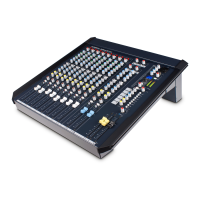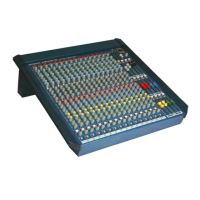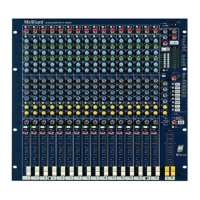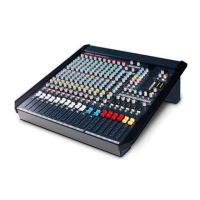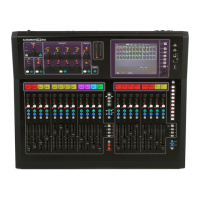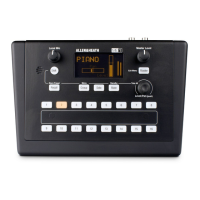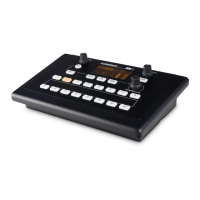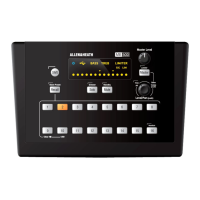
Do you have a question about the ALLEN & HEATH MixWizard WZ4 12:2 and is the answer not in the manual?
| Brand | ALLEN & HEATH |
|---|---|
| Model | MixWizard WZ4 12:2 |
| Category | Music Mixer |
| Language | English |
Details warranty terms, including operation, misuse, and approved repair conditions.
Covers warnings about electric shock, grounding, and internal component access.
Addresses safe operation, ventilation, heat, moisture, and servicing safety guidelines.
Important instructions for wiring the mains plug correctly according to color codes.
Advises on preventing physical damage and protecting the console from environmental factors.
Explains the purpose and content of the user guide, including product support information.
Introduces MixWizard series, highlighting features and differences between WZ 16:2 and WZ 12:2 models.
Instructions for setting up the console for free standing operation with side trims.
Guidance on removing trims and rotating the pod for rack mounting the console.
Explains the importance of grounding for safety and audio performance.
Provides best practices for powering the console on and off, especially with amplifiers.
Illustrates common audio connectors like XLR, TRS, and RCA for signal transmission.
Shows wiring configurations for various input and output connections, including adapters.
Explains how to prevent and resolve hum and buzz caused by ground loops.
Details the principles of balanced connections for noise rejection and signal integrity.
Diagram showing rear panel inputs and outputs for the WZ4 16:2 model.
Diagram showing rear panel inputs and outputs for the WZ4 12:2 model.
Describes the MIC XLR and LINE TRS jack inputs, including phantom power warnings.
Details the stereo return inputs and their routing options for mono signals.
Explains the function of insert points and impedance balanced direct outputs.
Details the main mix outputs, mono sum, and AUX6 output options.
Describes the impedance balanced TRS aux sends and optional balanced drivers.
Explains the configurable AB output and the footswitch for effects mute.
Details controls for phantom power, input attenuation, and gain adjustment.
Explains the high-pass filter and the 4-band semi-parametric EQ for tone shaping.
Describes how aux send rotary controls adjust signal level and pre/post options.
Explains channel controls for panning, muting, monitoring, signal presence, and level faders.
Details dual stereo inputs, routing modes, and gain adjustment for stereo channels.
Explains the fixed frequency EQ and aux send behavior for stereo channels.
Covers channel controls for balancing, muting, monitoring, and level for stereo inputs.
Introduces the digital effects processor, its routing, and aux send capabilities.
Guides on selecting effects, changing parameters, and using tap tempo features.
Explains dual effects crossfeed, ST1/ST5 LEV, and FX MUTE functionality.
Details master level controls for aux sends, affecting output and internal effects.
Explains LR fader masters and the M fader master for mono sum or aux control.
Describes ST2/ST6 return routing and the comprehensive console monitoring system.
Details AB output configuration for mixes or monitors and potential impedance balanced options.
Guides on setting signal levels for best console performance and headroom.
Explains how to use meters for setting gain and monitoring signal presence.
Defines key terms like headroom, SNR, and dynamic range for audio signal management.
Lists detailed performance metrics including output levels, frequency response, and noise.
Provides dimensions, weight, and mounting details for the console.
Summarizes input sensitivities and levels for mono and stereo channels.
Details outputs, aux sends, direct out, AB out, headphones, and lamp connections.
Lists part numbers for console models and optional kits.
Illustrates the internal signal path and processing blocks for the WZ4 16:2 mixer.
Illustrates the internal signal path and processing blocks for the WZ4 12:2 mixer.
Details procedures for removing the base and accessing internal assemblies for configuration.
Explains jumper and solder options for customizing channel and output behavior.
Configures mono channel aux sends, direct outputs, and pre/post settings.
Details stereo channel aux settings, stereo/mono aux sources, and effects return configuration.
Explains how to set the AB output source to pre or post LR faders.
Details the optional IC for electronically balanced aux outputs at +4dBu.
Describes the USB option card for computer recording and monitoring.
Provides a template for recording console settings for the WZ4 12:2 model.
Provides a template for recording console settings for the WZ4 16:2 model.
